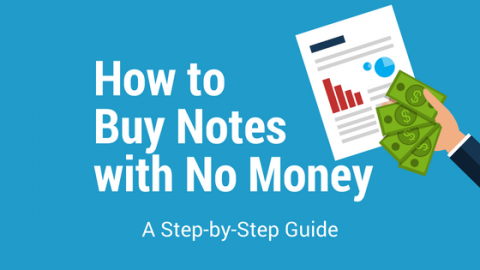Finding the money to invest in the mortgage note business may seem like a daunting challenge but in this article we will show you 5 ways to buy notes with no money

How do you get into the note business with no money of your own?
If you’ve just got to change the dynamics of your own income and wealth, and you are tired of sitting on the sidelines while all these others guys are making so much money, then the note business could definitely be for you.
The biggest challenge for any new note investor always seems like needing more money. It can feel like that for many successful note investors and fund managers who want to take things to the next level or see an opportunity they really want to seize on too.
In fact you can get started buying notes with no money if you focus on getting good at this one thing. What’s the one thing?
Let’s find out.
In this article you will learn:
Whether you need extra funds to put kids through college, build up your nest egg, or live a more flexible, financially free life, smart mortgage note investing can definitely help you get there. And you don’t need a pile of cash to get started in this business; a lot of successful investors started with minimal funds.
Here are the best ways to get into note investing with no money:
1. Partner Up

There are a lot of other individuals out there who would like to start investing in notes or do it on a larger scale. Often they may not have all the cash on their own to take down the size pools that are currently for sale. Others may just prefer to spread their risk by putting smaller amounts of their capital across more deals.
There are many small groups of friends and local investors who are pooling their capital too. They may have the money and the desire to invest in notes. They may just not have the time, expertise or connections to find good deals. That’s the perfect opportunity for you.
If you can bring the hustle, some knowledge they don’t have, new connections, and put in the time to find the note deals, you can cut yourself in as a partner and take an equity split.
My friend Michael Ruscica, shared a story with me about how he got into the mortgage note business and established a profitable company using the asset scout technique.
He got into the note business by going out and finding deals and giving them to his friends. On the first couple of trades that he did, he didn’t ask for a dime. He was trying to establish his credibility as someone who can follow through with the deal.
He had a good understanding of the note business but didn’t have the capital to go out and buy 85 deals on his first pull. So, he got seven investors together and they bought 84 deals on his first trade!
This can turn into a BIG business
There are many guys out there working on private placement memorandums, creating investment firms and hedge funds. They are pooling together capital, but still need deal flow.
Those are the people that need help in their business. They need more notes and they need clerical help. They may need scouts to find more notes. There’s tons of things to do in this business if you don’t have any capital, but you want to be in the business.
2. Find Note Pools & Cherry Pick Notes for Yourself

Mortgage notes are more commonly sold in wholesale pools (bulk) than individually. Note every note in any pool is going to be the perfect fit for any one investor or group. Some might prefer loans in New York. Others in Florida or Oregon. You just don’t get the choice. You take the good with the others.
This is the perfect opportunity for you to inject yourself into some deals and get some notes that work great for you to get started with.
The way that you approach this is you’d go out and you’d find the notes. Let’s suppose you find a pool of twenty notes. You select a couple of those notes that would be right for your personal portfolio, that you’d like to acquire and keep.
Then price your offering so that the other eighteen notes that you’re selling on to the investor cover the cost of everything, including the two that you’re carving off for yourself.
You would present that you have a package of eighteen for a certain price. Then included in that price would be the cost of the two that you’re carving off for yourself.
You use your buyer’s money to purchase the whole package. Break off yours, and pass on the rest. Win-win-win.
Work your notes. Go find another package and do the same thing again.
3. Raise Money or Flip Notes to Existing Note Investors

You can go out to ABC Hedge Fund and tell them exactly what you are looking for. They send a list of 20 notes, and each asset is $50k totalling $1M. Now that’s face value.
That’s what’s called the unpaid principal balance (UPB) of a million dollars. Usually we’re not going to pay a million dollars for that, because that’s no fun!
Say that you can pay 20 cents on the dollar for those assets. $1M time 0.2 equals $200k. When you bring an investor in to buy this $200k package of notes, it’s not going to be $200k. It’s going to be $220k. That’s the conversation that to have from day one with the new investor. You say that you just found a million dollars worth of notes for 22 cents on the dollar.
That’s normal terminology when you’re talking to a bank and when you’re talking to an investor. “How much are we paying for these things? We’re paying 22 cents.†So, that two cents is yours. That’s for all of the hassle of going out, and finding the hedge fund.
All the work put in is worth the $20k.
Now ABC Hedge Fund Company is doing business with you. They may know that you’re bringing in another investor, that’s fine. Their relationship is with you! All of the conversations are yours. Your end investor doesn’t even know that it’s ABC Hedge Fund Company that is the source until after the closing. Any questions that the investor has you relay back to ABC Hedge Fund Company and get those questions answered. That’s the job as a note broker.
How to make sure you get paid
At this point, when you are presenting your offer and they accept it at an agreed price, they send you a prepared document called a purchase and sale agreement (PSA). What you would ask for is one in PDF format which you can actually sign. A hard copy that’s an un-editable document. You also want a copy of it in Word, which is an editable document format.
Now you can go in there and use that same document, change out the names from ABC Hedge Fund to yours. Then go and change the amount from $200k to $220k when relaying the same document out to investors. That way you are protected from the left side and to the right side when it passes through to the end buyer.
So, when getting started with no money, first you are going to line up a couple of guys who have a couple of bucks. Then start looking for deals.
When you find that deal you’re going to go ahead and do the analysis on it. Put in an offer on it yourself, in your own name. All based on a PSA that’s probably going to be provided by the seller.
Analysis
This is probably the most important thing. Not only because it’s important because you don’t want to go out and buy junk, but because this is when you build the relationship on both sides of the trade.
Let’s start with your end buyer. You’ve got a guy that you met at the local REIA real estate meeting. He’s got $50k that he wants to spend on a couple of non-performing notes, either firsts or seconds.
You and the end buyer need to sit down and do the due diligence together. That’s your value add. That’s why you’re going to make $20k on this deal. You’re going to sit down with the headphones on, the laptop in front of you and Google Docs, pulling zero values and all of that other fun stuff on the research end of it. That’s the end of the business that you need to know.
That’s going to be your value that you bring to the table. Not only for the end buyer, but then when you go to present your offer to the seller. You’re going to say, “listen, these notes aren’t what you say they are. They aren’t what you think they are. They are…†It’s kind of like you’re the appraiser pulling up the comps. You might end up saying, “Oh man, there is no kitchen in this house, there is no backyard. All of the properties around here are 50×100, and this is a 25×75â€. You do this in order to get a better deal.
Hard work is key
This business is work. Never think that this is a get rich quick scheme. You’re going to have to pick up the phone. You’re going to have to have some “stones,†and you’re going to have to work some deals and actually bring some value. A lot of people don’t get that.
So, ABC Company sends a list of notes. First scrub the tape. Say you don’t buy anything in New Jersey, New York or Florida, those are your parameters. You just eliminated 25% of the tape. That’s good because you don’t have to go through and go to zero. Now and this all comes down to what the bank is actually giving you. The bank may have just had an appraiser out to the property three weeks ago. Though I would still go to Zillow just to confirm.
Always verify your information

There have been some really bad appraisals over the last couple of years, for various reasons. It’s okay if they’re bad on the low side, but when they’re bad on the high side it makes it hard for everybody.
Take all the information they give you with a grain of salt. Go ahead and back up and confirm. “Trust, but verify.â€
You can go to Zillow,Trulia or to Realtor.com. See what’s for sale in the area. Take 20% off of those prices and you’ll probably get pretty close for a three bed, one bath as long as it’s not in a rural area.
The next thing to do is plug in a column for value of the property. Then have your servicing company go ahead and pull a credit report. On a second mortgage, you’ll do a soft hit credit report, so that you can evaluate and look at the borrower to see what’s going on with the first mortgage.
The first mortgage is important when you’re buying the second mortgage. In order to find that information expect you will have to pay about $5 for a credit report. Review the mortgage to see if the first mortgage is current or not.
On many seconds the borrower is paying on the first mortgage but not on the second mortgage The strategy is all that a phone call and an educated conversation with this borrower to say, “listen, just so you know, we’re able to foreclose on you just as easily as the first mortgage I don’t know if you know that.†That’s a wake up call. If that wake up call doesn’t work then go ahead and have an attorney send a letter over and hopefully that will shake them up a little bit.
When you look at the credit report and we see that the borrower is current on their first mortgage and delinquent on our second mortgage, that’s another column on your spreadsheet. , You can rate that as a one through five and have a weighted scale. Some companies are out there looking at 27 points of interest. If you’re busy you may look at just 5.
Look at the credit report, condition of the first mortgage, then the property value. Have a column do a subtraction between the property value, and the first mortgage amount. You’re left with a positive or a negative number. A lot of times they’re negative. Meaning property is worth $100,000 and there’s $120,000 first mortgage.
Do you buy that $50,000 second mortgage behind that first mortgage? It depends. It depends on the price that you’re able to purchase this at, the neighborhood that it’s in and what the credit report looks like.
Sometimes they’re paying on everything. They’re paying their car loans, the credit cards, they’re paying the first mortgage, but they’re not paying the second. Who’s in that house? Somebody that wants to stay there! It’s because they don’t get that they’re at risk. They don’t get it. No one’s ever really bothered them about it for years or they’ve never been able to really work anything out with the old bank that owned these liens. Now you’re the guy who comes in and says, “listen, if you give me the $3,000 down I can lower your interest payment, I can lower your monthly payment, let’s make something work.â€
Examples
You find out that the borrower is a truck driver and it’s a seasonal trucking business. He makes a ton of money in the wintertime and he takes the summers off. No wonder he can’t pay his mortgage in the summer. So, he stopped paying altogether. You say let’s pay this over eight months. Pay me from October to March. Let’s up the payment a little bit from October to March and you take the summer off. You don’t have to pay me anything.
Perhaps you give borrowers a break because she is a grandmother who wants to get her grandson some presents for Christmas. So, she just wants to make an interest only payment for the month of December.
Let her, because she’s been paying like clockwork since the day you worked that loan out for her. Every year you’ll get the phone call that she needs to get her grandson a Christmas present, “do you mind if I make an interest only payment for the month of December?â€
That’s definitely not the same as working with the bank.Though you can get your money out of that thing many times over. That’s the note that’s in the heart of Cleveland, Ohio which was a real hard hit area. This little old lady has been in this house forever. She was raised with all the family in there, and the place looks immaculate on Google Maps. You lowered her interest rate to 2%. So her interest payment is like $13 bucks.That’s the kind of cool stuff that you can do if you own the note.
How to call and the lingo
On your first call to a bank for notes they may not know what the heck you’re talking about and keep pushing you over into the REO department. Let’s say you’re talking to someone and even though Wells Fargo sells notes everybody that you talk to at Wells Fargo says, “we don’t do that!†That’s when to keep trying to knock on a different door until you find a guy that goes.
There are different types of banking terms that you can become familiar with online. Knowing the lingo can make a whole lot of difference in getting to the notes and presenting yourself as a serious seller of notes. Iit could just be a 20-minute lesson for yourself that could pay off big time.
Check out some of the Distressed Pro training and dig deeper into banking terms and lingo so that you can get where you want to go faster and sound like a pro.
What is UPB?
When you’re talking about the first or second mortgages, ‘UPB’ gets thrown around a lot. UPB stands for Unpaid Principal Balance. Now, there’s a difference between unpaid principal balance and the loan payoff or payoffs amount. Because when you ask for the payoff amount there may be two years worth of missed payments that are going to get added together.
So, you have the accrued interest and payments that are going to merged together with the UPB, that’s going to create the total payoff.
Accrual and non-accrual is how banks divide up their assets. Whether they’re accruing interest or if they’re not accruing interest. If you’re not accruing interest, what are they? Well, they’re a problem. These assets are usually in the charged off category. These assets go into non-accrual. It means that there is no longer any hope of them being repaid according to terms.
We’re actually after the non-accrual assets that this bank is holding. That’s kind of the lingo that is used in a bank conversation. Instead of saying “do you have any notes that you don’t like?†Bank guys don’t call them notes, they call them assets. They call them by what bucket they’re in. They’re in the accrual bucket, the non-accrual bucket or the charge off bucket.
4. Make Commissions & Use Your Earnings to Invest

Why not start by finding notes for other investors? Make commissions your new found money. Roll those paydays into acquisitions.
Approach this is the same way that you would approach most of these opportunities. That is to first pursue finding the notes. It’s like listings for real estate agents. If you have the product, all the buyers have to come to you if they want it.
Once you do, and you have found buyers for these notes, there’s two ways you can get paid. You can either represent the buyer or you can represent the seller. Often times in this business it’s the buyer you represent.
What you need then is to have some discipline. So, that when you sell the notes, you’re setting aside that you’re making as commissions on those purchases. You should probably do it in a special ‘bucket’ so you don’t touch it or burn through it. Put it in a safe, or in a special account. Set that aside for acquisition purposes for yourself in the future.
5. Raise Debt & Equity to Purchase Notes

Trying to either raise all the money to buy a bulk package of notes, or borrow all the money yourself may seem a little daunting the first time. Why not do a combination of both?
Find ways to borrow half the money you need
Find other investors with the capital for the other half of the money you need
This can be an easier sale to lenders, when you have half the money you want already. The same goes for raising money from other investors, when you tell them you are putting in half of the money yourself.
For example; if you’re going to buy a pool of second mortgages that costs $100k, you can raise $50k from independent investors, then put together your own debt financing for the other $50k.
You can use that to take the package down. Then you pay off your debt with the proceeds from the sale of notes or properties, or with the cash flow you are receiving from mortgage or rent payments.
Do note that any time you take on debt to make a speculative investment like this, you are taking on additional risk. Because if the investor fails you still owe the debt.
We don’t know of any loan programs specifically able to use the notes as the collateral. So, in this case, you would to leverage personal guarantees or business lines of credit in order to get that.
This might include:
- Home equity lines of credit
- Business lines of credit
- Business loans
- Credit cards
- Crowdfunding
- Personal signature loans and lines of credit
We do have some options for 50% LTV financing on the acquisition of some commercial notes, but not for residential home loans.
Note that this doesn’t have to be a 50/50 split between debt and equity fundraising. It could be 60/40, 70/30, or even 90/10. It’s up to you, and what you find easiest.
Conclusion
There are clearly multiple ways to get started in note investing, get unstuck or scale the successes you have achieved already. Even if you are tight on money right now. In fact, once you champion these money strategies, you’ll wonder what was ever stopping you before, and may never want to put your own cash into deals in the future.
These have been just some of the ways that others have made breakthroughs and changed their own financial dynamics for the better.
To learn more, or if you’ve been out there looking for note deals already and are just sick and tired of the broker chains and dead ends – go to DistressedPro training course RIGHT NOW, and sign up for your FREE 14-part mini course, where you’ll learn everything that you need to know about how to find and qualify the right banks. You’ll learn how to know who is selling notes and REO, how to find them, who to contact and more.


Great article Brecht, you constantly provide awesome content, advice, and info. Keep up the great work!
Thank YOU Chris, folks are still getting good value out of the case studies you shared.
I found this to be very helpful and will continue to reference this article. THANK YOU Brecht!
You were talking about commissions, how do you set that up so you are safe guarded. Say if I am representing the buyer and I want 3 percent. Is there somewhere in a contract that would stipulate that? and how do I give the info but not where they might not undercut me for due diligence? Sorry for the questions. I am trying to make a sell and then buy your course.
Hi Justin, Thanks for the questions. Yes, you stipulate the commission either in the contract or in advance in a separate agreement. If you’re working with buyers and you’re not confident that they won’t circumvent then I recommend you have them sign an NCND / Non-Circumvent as well as a fee agreement, unless you’re representing sellers.
Good Article for the novice , Like myself!